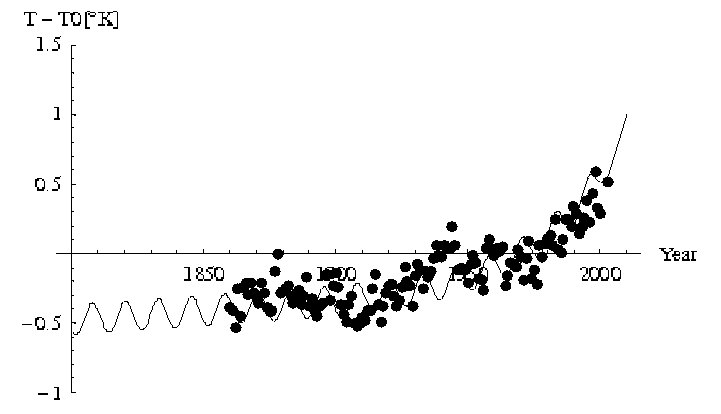Pre-Print a cura degli autori. Originale pubblicato su:
Mem. S. A. It. Vol. 76, 1015
© SAIt 2005
Memorie della Società Astronomica Italiana
1871 Società degli Spettroscopisti
Global warming: solar variability and energy consumption
A. Nigro1, A. Pagano2, 1, and F. Zuccarello1
1 Dipartimento di Fisica e di Astronomia Università di Catania, 64 Via S. Sofia, I-95123 Catania, Italy
2 Istituto Nazionale di Fisica Nucleare, 64 Via S. Sofia, I-95123 Catania, Italy
Abstract. Recent measurements support evidence for short-term global warming of the earth's surface. The average trend of the earth's surface anomaly as a function of the time was fitted by a simple thermodynamical model including short-term variation of the solar irradiance as well as antropogenic forcing.
Key words. Sun: variability – Earth: surface – Earth: warming – Economy: Energy – Economy: consumption.
1. Introduction
Measurements of temperature occurring in the earth's surface have shown that these temperatures were increasing during 19th and 20th centuries and, within the adopted accuracy of the measurements, from early 1860 to 2003, the average difference in earth's surface temperature (anomaly) has been estimated to be +0.6±0.2 °C (Jones et al. 1999). From recent analysis of the solar cycle influence on terrestrial climate over the past 2000 years, the presence of a short term thermal forcing of anthropogenic origin in the late 20th century is deduced Jones (2005). However, a clear simulation of anthropogenic forcing is still an open problem. For example, global climate models of earth's temperature variation for different scenarios assuming anthropogenic green-house gas forcing only or green- house gas plus aerosol forcing fail to reproduce the universal scaling behavior of the observed records Govindan et al. (2002). In this contribution, the influence of energy consumption rate and the short term solar variability are taken into account on global warming of the earth's surface in the frame of a simple thermodynamic model.
2. Model description and data analysis
The Energy required as the necessary input by industries and civil uses is totally absorberd by earth's surface and consequently degraded as thermal energy (Davis 1990) in a time scale which is short compared with the short term solar variability. So, for vanishing value of the earth thermal capacity, an increase of the temperature at the earth's surface is expected Wilson and Jones (1990). If we consider the earth's surface as a body of given thermal heat capacity ceff, a simple equation for energy conservation is written: (Ehrlich et al. 1970)
![]() ,
,
![]() is
the annual variation of the temperature T,
is
the annual variation of the temperature T,
![]() is
the flux of solar radiation absorbed by the earth's surface,
is
the flux of solar radiation absorbed by the earth's surface,
![]() is
the short term variation of the solar irradiance (Lockwood et al.
2000),
is
the short term variation of the solar irradiance (Lockwood et al.
2000),
![]() is
the global flux of energy consumption that is assumed to be degraded
in thermal energy, and
is
the global flux of energy consumption that is assumed to be degraded
in thermal energy, and
![]() is
the Stefan-Boltzmann radiation emission. The annual rate
is
the Stefan-Boltzmann radiation emission. The annual rate
![]() was
evaluated by fitting the experimental data of global energy
consumption rate over the last century, starting from
was
evaluated by fitting the experimental data of global energy
consumption rate over the last century, starting from
![]() .
A linear approximation of the energy conservation equation was solved
with the free parameter ceff and the solution was
used to fit the experimental data. In Fig.1, the result of this
preliminary analysis is shown.
.
A linear approximation of the energy conservation equation was solved
with the free parameter ceff and the solution was
used to fit the experimental data. In Fig.1, the result of this
preliminary analysis is shown.

Fig.1 Behavior of the experimental earth's surface temperature anomaly (Jones et al. 1999) fitted by the simple solution of the thermodynamic model (full line).
The order of magnitude of the heat capacity of earth's surface, that is involved in the warming process was evaluated to be
![]() ,
,
suggesting a value for the external thickness of the earth's surface involved in the warming process of about 3.5±2 m. Notice that the fluctuation of the data around the average behavior are in agreement with the periodic short-term variation of solar irradiance of a period ≈ 12 year.
3. Conclusions
Global warming of Earths surface during the last two centuries has been analyzed by a simple thermodynamic model including both anthropogenic and solar forcing. The average trend of the temperature anomaly as a function of the time in the period 1860 – 2000 years, was found similar to the one observed in world energy consumption rate. The magnitude of the termal capacitance of earth's surface is consistent with the assumption of an energy transfer mechanism produced at the earth's surface. The fluctuation of the data around the average behavior was found to be in agreement with the periodic short-term variation of solar irradiance.
Acknowledgements. Sincere thanks to Cesare Marchetti of IIASA of Vienna, for the data of world energy consumption.
References
Jones, P.D., New, M., Parker, D.E., Martin, S., & Rigor, I.G. 1999, Reviews of Geophysics, 37, 173
Jones, P.D. 2005, this volume
Govindan, R.B., Vyushin, D., Bunde, A., Brenner, S., Havlin, S., & Schellnhuber, H. J. 2002, arXiv:cond- mat/ 0206040 v1
Davis, G.R. 1990, Scientific American, 263, 21
Wilson, R., & Jones, W.J. 1974, “Energy, Ecology and the environment”, Academic press, INC-New York – San Francisco – London, chapter 4 and references therein
Ehrlich, P.R., & Ehrlich, A.H. 1970, Bull. At. Sci. 26, 69
Lockwood, M., & Foster, S., 2000 ESA SP-463, 25